Day 2 of a three day long weekend of Spring Tours today. It was forecast to be cloudy, and it was thick enough for some intermittent light drizzle early morning which thankfully cleared up after an hour or two. It was still windy, with a fresh ENE. We might have walked out to the dunes from Burnham Overy today, but given the wind and early drizzle we decided to make our way in that direction from Holkham, where we could get a bit of shelter in the lee of the pines or in the hides if need be.
Having parked at Lady Anne’s Drive, we walked up towards the pines. A Sedge Warbler had found a sheltered spot in the brambles to sing from, and we were able to get a great look at it through the scope.
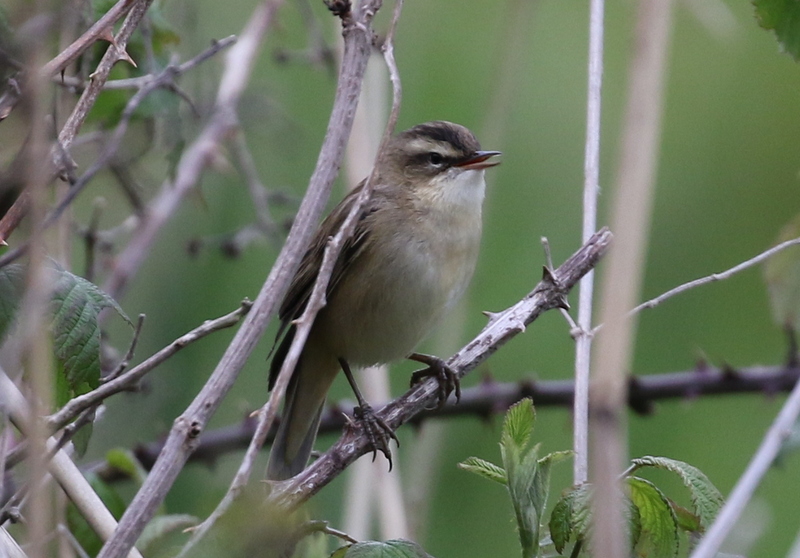 Sedge Warbler – singing from the shelter of the brambles
Sedge Warbler – singing from the shelter of the brambles
As we walked west along the path, in the lee of the pines, we could hear lots of warblers singing in the trees. As well as more Sedge Warblers, there were several Blackcaps and Common Whitethroats and a distant Willow Warbler. One of the Chiffchaffs perched up nicely where we could get it in the scope. A Cetti’s Warbler shouted from deep in the bushes, as usual.
A Cuckoo was singing in the trees but we couldn’t see it on our way out. We stopped at Salts Hole to scan the grazing marshes beyond and about thirty Swallows were feeding around the trees in the reeds and low over the grass nearby, presumably trying to find food in this more sheltered spot.
One of the group had seen a Bullfinch fly over the path on our way there, but it had disappeared. When we got to Washington Hide,it flew in and landed in one of the bushes in the reeds and even stayed long enough for us to get it in the scope, a smart pink male. An occasional Spoonbill flew past, heading out to feed or back into the colony.
A female Marsh Harrier perched up on the top of a bush and a little while later a male flew in carrying some prey and landed down in the reeds. We had hoped we might see a food pass, but presumably it had decided to eat whatever it had caught itself. The Swallows were now hawking for insects out over the grazing marshes and as we looked out towards them we could see there were lots of Swifts zooming back and forth now too.
Continuing our way west, a Jay flew across the path and landed in an oak tree briefly. We could hear a Goldcrest singing and a pair of them appeared in a low hawthorn before working their way through the trees and past us. A Treecreeper was singing in the pines, but was too deep in to see. A couple of Coal Tits were feeding in the emerging leaves of an oak tree.
We were told there had been a Peregrine out on the beach on a kill so when we got to the crosstracks, we made our way out to the dunes for a quick look. It wasn’t there any more and it was cold and windy here, so we beat a hasty retreat and headed back to Joe Jordan hide.
There were a couple of people in the hide already when we walked up the steps. As we went in, they kindly told us that a Bittern had just flown in to a clump of rushes not far from the hide. We quickly got seated and after just a couple of minutes it walked out in full view. It stood there for several seconds before walking back across the short grass and flying off again. What perfect timing!
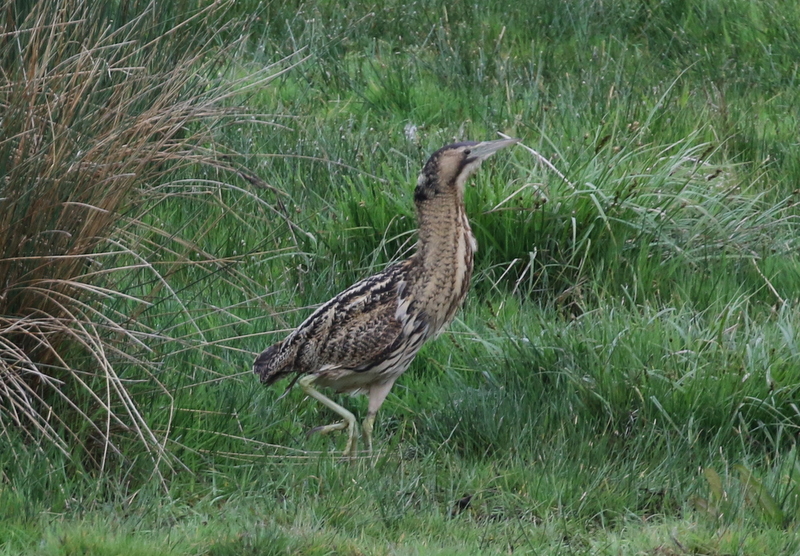 Bittern – walked out of the rushes shortly after we arrived in Joe Jordan Hide
Bittern – walked out of the rushes shortly after we arrived in Joe Jordan Hide
As well as the Bittern, there were lots of other things to see here too. More Spoonbills were coming and going, flying in and out of the trees. Most landed out of view, but two or three flew down to the pool in front to collect nest material, giving us a better look at them. A Great White Egret spent most of its time hiding in a reedy ditch, walking out onto the bank briefly where we could see it, before flying off behind the trees. A single Pink-footed Goose was asleep in the grass, most likely one which has been shot and injured and cannot make the journey back to Iceland to breed.
The weather had improved considerably now, so we decided to make our way along to the west end of the pines and up into the dunes. As we got to the gate at the end of the track, we stopped to look out over the grazing marshes as a male Marsh Harrier flew past. Several thrushes flew out of the bushes and landed in the short grass and you can imagine our surprise when we found they were two Mistle Thrushes, a Ring Ouzel and a Fieldfare!
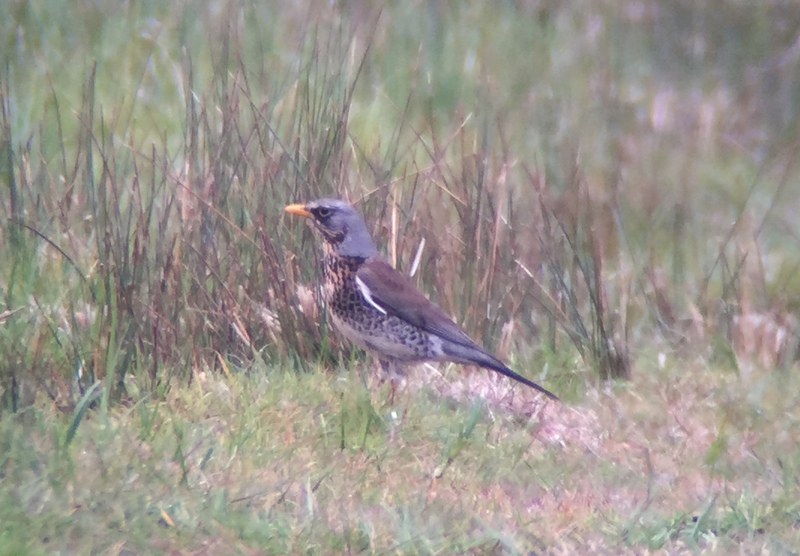 Fieldfare – a late straggler, which should be on its way to Scandinavia
Fieldfare – a late straggler, which should be on its way to Scandinavia
Fieldfare is a winter visitor here and most have long since departed back to Scandinavia. We had a great view of both it and the Mistle Thrushes from the gate, but the Ring Ouzel quickly disappeared into a dip in the ground. So we walked round and up into the edge of the dunes where we could look down on it – a smart male Ring Ouzel with a bright, clean white gorget.
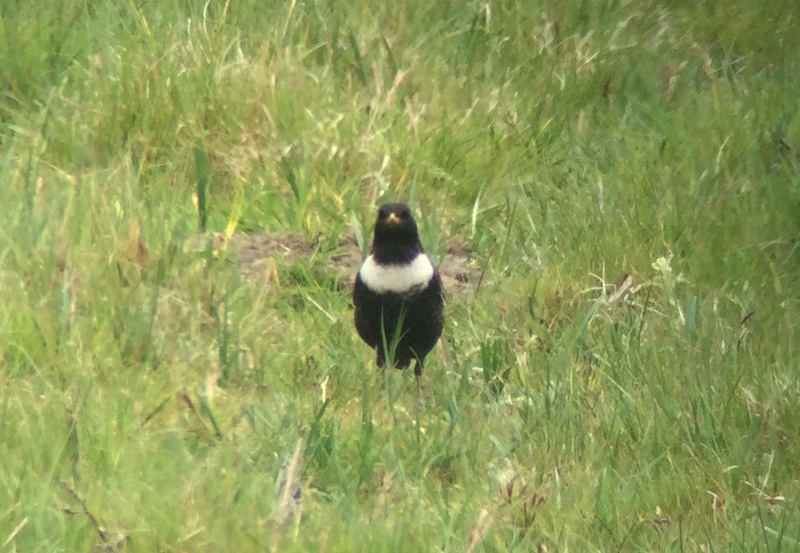 Ring Ouzel – a smart male with a white gorget
Ring Ouzel – a smart male with a white gorget
We made our way further up into the dunes and stopped for a while to admire the view. The bushes just beyond the fence here can be good for migrants, but they were quiet today in the wind. Scanning out across the grazing marshes a Great White Egret flew across and landed distantly out of view in some reeds and a second Great White Egret was visible about a mile away in the grass.
One of the group particularly wanted to get a better look at a Wheatear, so we walked a little further into the dunes to an area which they favour. We flushed two or three more Ring Ouzels from the dunes as we went. They were typically very flighty, and as soon as we appeared over a rise they were off.
When we got to the right spot, we quickly found a male Wheatear, hopping about on the short grass. Then a male Stonechat appeared on the fence a short distance ahead of us and when we looked, a second bird also on the fence a little further along turned out to be a stunning male Redstart. What a bonus! Everyone had a look at it through the scope before it dropped back behind the dune beyond.
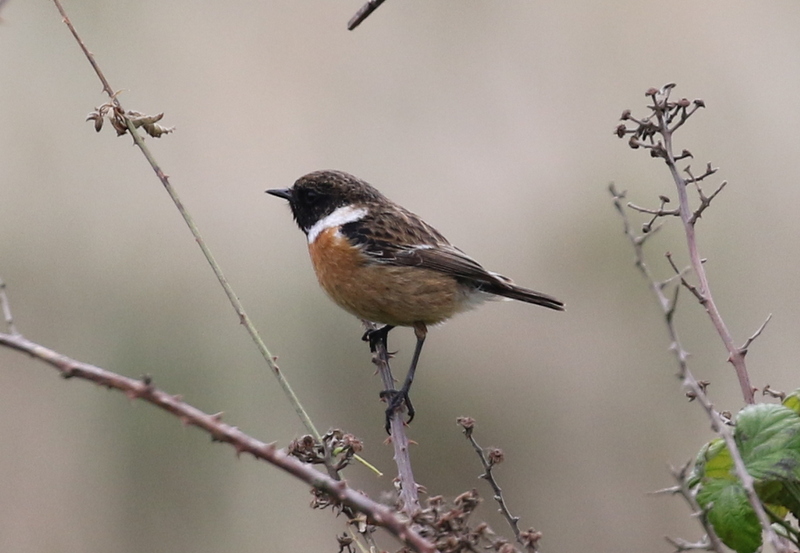 Stonechat – we saw a couple of males in the dunes today
Stonechat – we saw a couple of males in the dunes today
As we walked back through the dunes, we flushed another Wheatear which flew off ahead of us flashing its white rear, and another male Stonechat. It was nice to get back into the lee of the pines and out of the wind. We were almost back to Lady Anne’s Drive when we heard the Cuckoo singing again from the trees. It sounded quite close, but was in the back of a poplar behind a pine tree. Still, we managed to find an angle from which we could see it and get it in the scope so everyone could get a look at it.
It was lunchtime by the time we got back to the car, so we made use of the picnic tables at the top of Lady Anne’s Drive, which were reasonably sheltered from the wind by the pines. We had just sat down to eat when we noticed another Ring Ouzel along the edge of the field next to us, over by the hedge. It spent all the time we were eating feeding in the grass nearby.
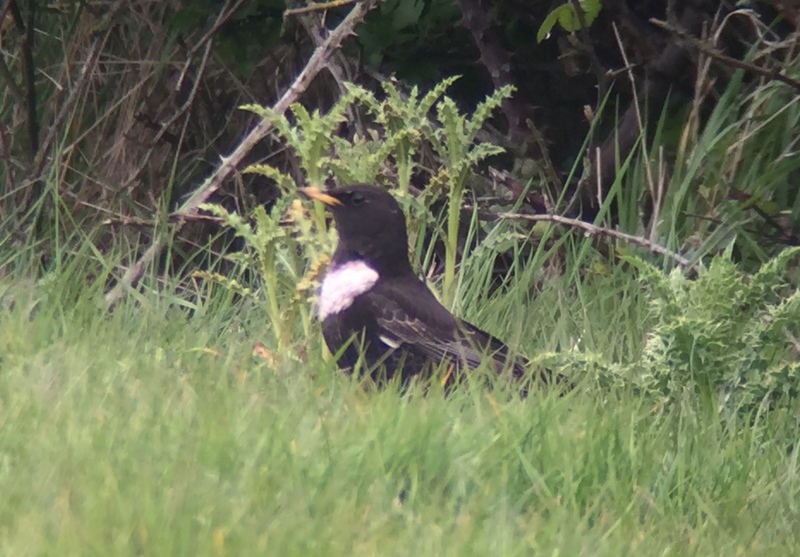 Ring Ouzel – feeding in the field next to where we were having lunch
Ring Ouzel – feeding in the field next to where we were having lunch
Yesterday, we had struggled to get good views of the Red-breasted Flycatcher at Holme, but we found out it was still there this morning and “showing well on and off”, or so we were told. We decided to head back there for another go. When we pulled into the car park, we could see a small crowd gathered in the corner. We got out and walked over and this time there was no need to wait – the Red-breasted Flycatcher was immediately on show!
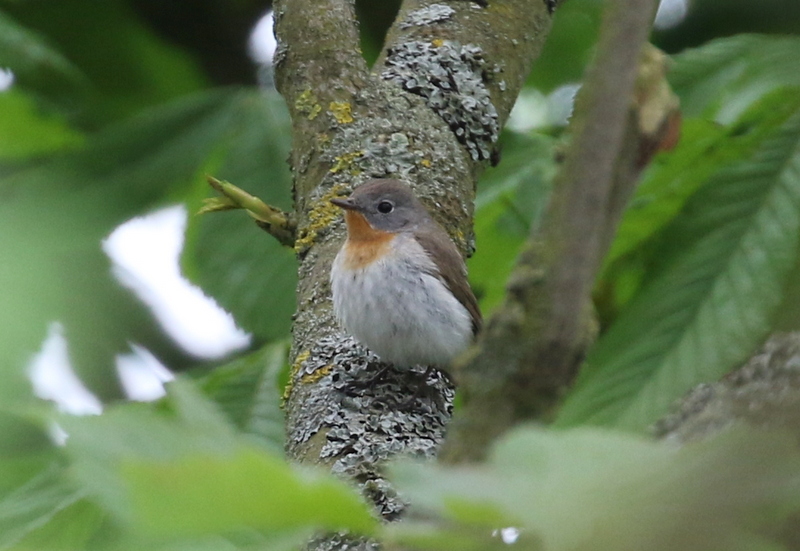 Red-breasted Flycatcher – feeding in the trees on the edge of the car park
Red-breasted Flycatcher – feeding in the trees on the edge of the car park
The Red-breasted Flycatcher was feeding in a sycamore right in the corner of the car park. It was very active, flying up after insects before landing back down on a branch, and very mobile, flitting between different parts of the tree. It was hard to see until it moved, but by spotting the movement and following it when it flew it was possible to see where it landed. Regularly it would perch where we could see it and quickly we all got great views of it. We even managed to get it in the scope on occasion.
It was a cracking male, with an orange (not really red!) throat and upper breast. When it flew and spread its tail, we could see the white outer edges to the base of the black tail. It called a couple of times, a dry rattle. Red-breasted Flycatchers breed in eastern Europe up through the Baltics into southern Scandinavia, so this one had been blown off course on its way north from its wintering grounds in western Asia. An exciting bird to see and well worth coming back again to see properly.
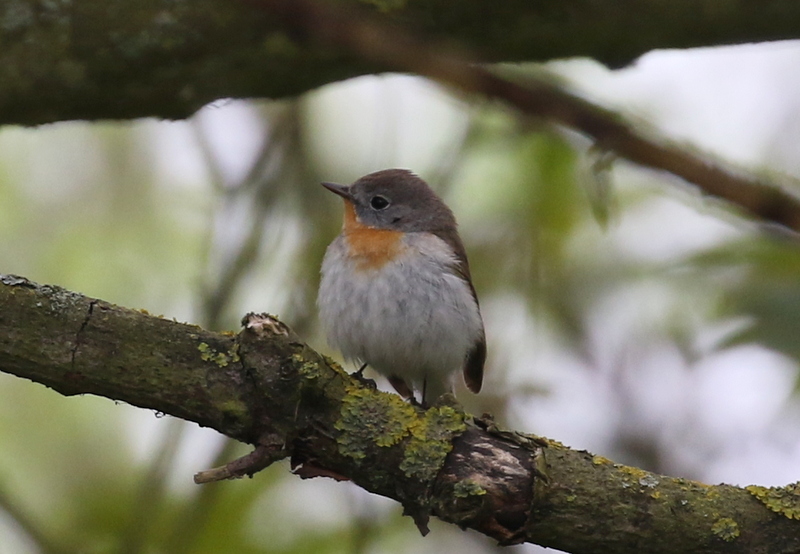 Red-breasted Flycatcher – blown off course on its way north
Red-breasted Flycatcher – blown off course on its way north
Eventually, we had to tear ourselves away and we walked back along the access road towards the horse paddocks. At first all we could see were Wheatears, but there were several of them here, males of different shades and a couple of females. We got some great looks at them through the scope.
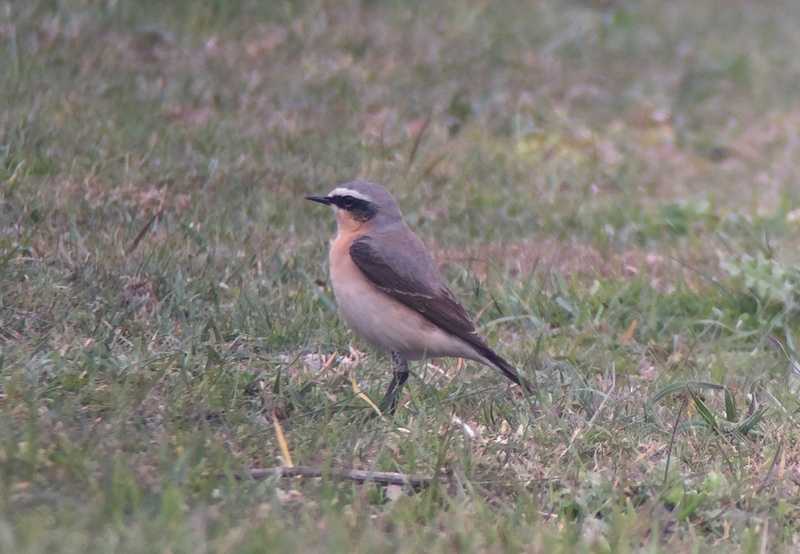 Wheatear – there were several in the horse paddocks at Holme
Wheatear – there were several in the horse paddocks at Holme
There was meant to be Redstart and Whinchat here too, but we couldn’t find them at first. After a short while, the Whinchat appeared on the fence at the back. It was a female, not as boldly marked as the males we had seen yesterday. It kept disappearing, at times feeding down on the ground, before reappearing back on one of the fences.
Then the Redstart finally showed itself as well, another male, our second of the day. It was very mobile too, not staying still for long. dropping down to the ground before flying back up to the fence or the brambles. We kept getting it in the scope and eventually everyone got to see its black face and contrasting silvery white forehead which caught the light face on. When it flew back up to the fence, sometimes it spread its tail which flashed orange red.
 Redstart – our second male of the day, at Holme
Redstart – our second male of the day, at Holme
The temperature had dropped noticeably now and it had turned slightly misty. It seemed a shame to leave the paddocks, with all these migrants here, but we made our way back to the car. We finished the day with a drive round the fields inland. We had hoped we might chance upon a Dotterel in one of the traditional fields they visit when on their way north, but we couldn’t find any today. We did surprise a Song Thrush which was bashing a snail on the tarmac on the edge of a minor road. A lone adult Mediterranean Gull walking around in a stoney field looked rather out of place and there were several Wheatears up here too.
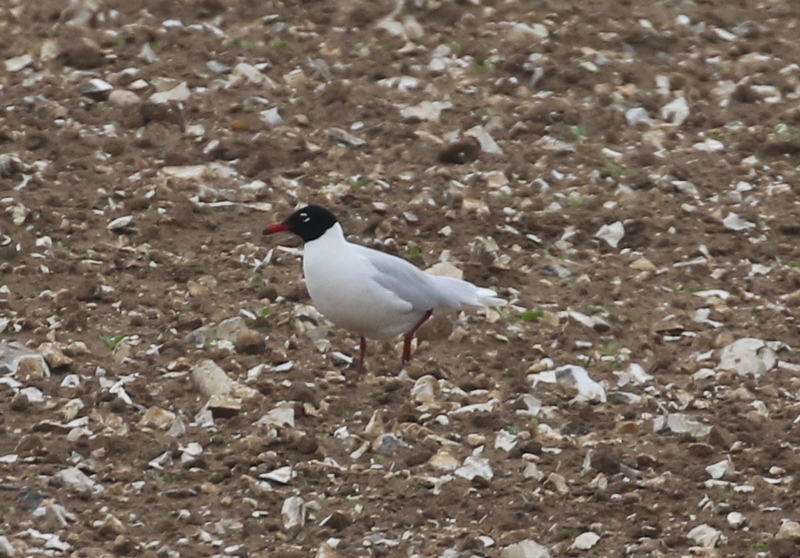 Mediterranean Gull – this adult was walking around in a field all on its own
Mediterranean Gull – this adult was walking around in a field all on its own
Then it was time to head for home, after a very exciting migrant-filled day.
















